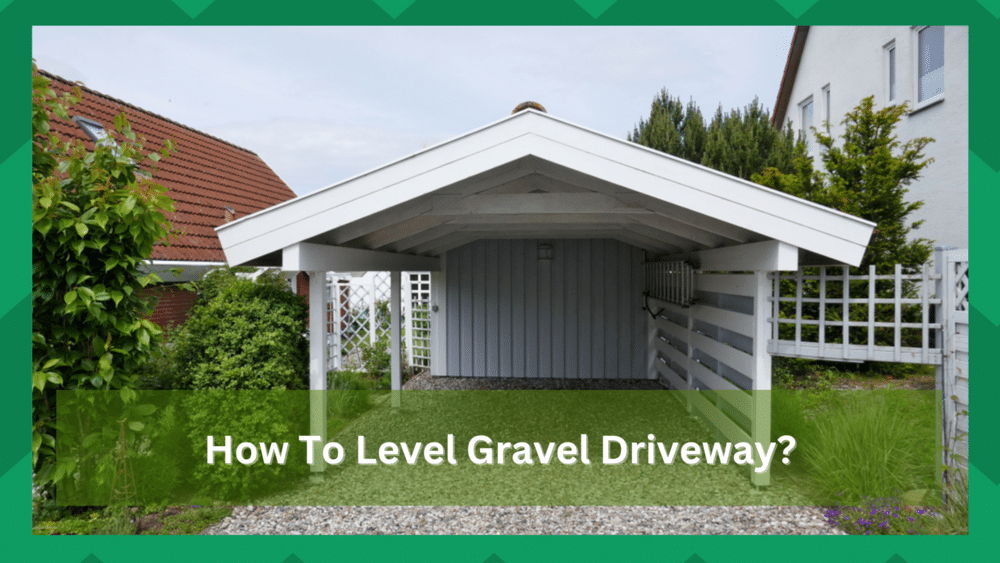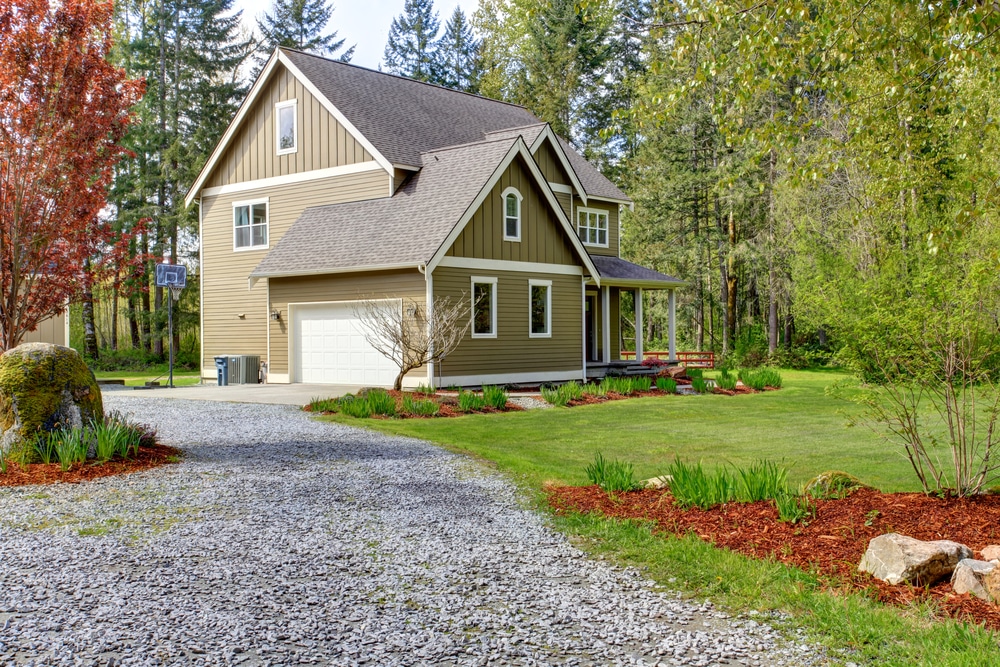
Landscaping the yard or driveway is one of the most demanding tasks that you have to do as a gardener. Relying on professional help can cost hundreds of dollars, depending upon the size of the project and the garden.
So, it is only sometimes a suitable option for gardeners to hire professionals for their landscaping projects.
Some gardeners have come forward with queries about how to level the gravel driveway. Let’s cover this issue if you struggle to manage the gravel in your driveway.
How To Level Gravel Driveway
Working with gravel can be quite difficult, especially when you’re a beginner.
Depending upon the size of the driveway, it can take days to get through the work at a steady pace. With that said, the best method to level a gravel driveway is by using three wooden planks and a weighted roller.
You will have to shovel the gravel on the driveway to make a guideline to start the process. Once the area is covered with sufficient gravel, you can continue the leveling process.
To level, the driveway put one plank of wood on each side. The distance between these two planks should match the length of the third plank.
So, after placing the two planks on the side, manage the depth of the planks and use the height of these planks as leverage to level the gravel.
Once the planks are secure at both ends, you have to put the third plank to connect the planks on both sides of the driveway.
Now, just put some extra gravel in front of the third plank and start dragging the plank across the length of the secured planks.
Repeat this process two to three times to perfectly level the gravel in the driveway. After leveling the gravel, you can rely on a weighted roller.
Make sure to cover the whole patch thoroughly to avoid issues in the future.
This process requires a lot of effort, and it would be better to get a friend or a family member to help you.
That way, you won’t have to spend as much time completing the project. Keep leveling the gravel driveway in patches and then fill in the holes left by the secured wooden planks afterward.
What to avoid doing when leveling a gravel driveway?
Leveling a gravel driveway is important to maintaining your home and keeping it looking great.
However, if you’re not careful, the job can quickly become overwhelming or even cause damage to your property.
To ensure that your leveling job goes smoothly, there are certain things you need to avoid doing when working on a gravel driveway.
First, never use heavy machinery such as bulldozers or backhoes without consulting an experienced professional.
This type of equipment is designed for larger projects and may cause irreparable damage if used improperly on a smaller-scale project like a residential driveway.
Secondly, never apply too much pressure while leveling the gravel; this can compact the material underneath and make it difficult for grass or plants to grow between stones.
Finally, take care not to mix different types of stone; this could lead to drainage issues that compromise your driveway’s integrity over time.
By following these simple tips, you’ll be able to successfully level out your gravel driveway without any problems.
Also, be mindful of the potential health risks associated with gravel driveways. The dust and dirt particles in the air can be hazardous to your lungs, so ensure you’re wearing proper protective gear when working on this type of project.
Additionally, wearing safety goggles when using saws or other tools that may cause shrapnel or fragments to fly up in the air is important. Taking these steps will ensure that your project is completed safely and efficiently.
It’s important to remember that leveling a gravel driveway isn’t a one-time job; it should be done periodically to keep your driveway looking its best.
Be sure to inspect the surface of your driveway regularly and address any issues that may be present.
By following these tips, you’ll find that leveling your gravel driveway is much simpler than anticipated.
Remember to stay safe and take the necessary precautions when working with heavy machinery or other sharp tools.
What can go wrong when leveling a gravel driveway?
Leveling a gravel driveway can be a rewarding project that adds to the aesthetic and value of your home.
However, if not done properly, it can also lead to costly repairs or damage to your home’s foundation.
Understanding what can go wrong when leveling a gravel driveway is important to avoid any potential issues down the road.
The most common issue is improper drainage which leads to water pooling on the surface, causing erosion and potholes over time.
Be mindful that if too much dirt is added during leveling, it could cause an uneven surface or create ridges where cars frequently travel, leading to further damage.
Finally, suppose proper steps are not taken while compacting the soil before adding new gravel.
In that case, this could result in loose stones being driven into lawns or flower beds surrounding the driveway and displacement of existing stones on its surface due to inadequate compaction.
Therefore, you must take all necessary precautions when planning your project for it to turn out just right.
Also, be mindful of any trees, shrubs, or other landscaping features which could be affected by the leveling of your driveway.
It’s best to consult with a professional before beginning any project.
Always remember that the quality of materials used will affect the longevity of your driveway in the long run.
With proper planning and care, leveling your gravel driveway can be a rewarding and successful project.
How to maintain a gravel driveway?
Maintaining a gravel driveway is an important task that requires regular upkeep and attention.
A well-maintained gravel driveway can last for years, adding to the aesthetic appeal of your property while also providing a safe and secure surface for cars, trucks, ATVs, or other vehicles.
Maintaining your gravel driveway with just a few simple steps is not difficult. Begin by inspecting your driveway at least once a year to check for any loose or washed-out materials, potholes, or other potential hazards.
Fill in any holes or depressions with new gravel and compact the material using either a hand tamper or a mechanical compactor.
It’s also important to remove any weeds or vegetation that may be growing within the gravel. Weed and grass removal can be done with a hand-held weed trimmer or an ATV-mounted spraying system to treat larger areas.
To keep your driveway in peak condition, it’s important to grade the surface and rake any loose material towards the center of the roadway.
This will help maintain proper drainage and prevent washouts and other damage.
It’s equally important to replenish your gravel driveway with new material regularly. Depending on the size of your driveway and the traffic, you may need to add fresh gravel every six months or so.
When adding fresh gravel, be sure to use the same type of material that was used to build the driveway.
Furthermore, take steps to prevent vehicles from leaving gouges or ruts in your gravel driveways.
Using speed bumps or speed humps can slow down vehicles and reduce the risk of damage.
Over and above, installing a barrier at the end of your driveway will help keep cars from veering off onto grassy areas or other sensitive surfaces.
By following these simple steps, you can ensure that your gravel driveway remains in top condition for years to come.
With regular maintenance and care, your driveway will remain safe, secure, and aesthetically pleasing for many years.
What’s the best material to level a driveway with?
Leveling a driveway can be important in ensuring your home is safe and secure. The material you use to level your driveway will depend on the type of surface it has, as well as the climate in which you live.
Gravel, asphalt, concrete, and pavers are all popular materials for leveling driveways.
Each type of material has unique advantages and disadvantages; depending on your needs and budget, one may be better suited than another for your particular situation.
To be on the safer side, gravel is usually the best material to level a driveway with.
Gravel can be easily spread over uneven surfaces, adding traction for vehicles driving on the surface. It’s also an inexpensive option that requires minimal maintenance.
To Conclude
While leveling the gravel driveway, start by securing two planks of wood on both sides. Then put the third piece of wood on top of the secured sides to support the leveling process.
At this point, all you have to do is put extra gravel in front of the third wooden plank and drag down the plank along the length of the two wooden planks.
The only downside of this method is that you will have to cover the driveway in multiple patches.


